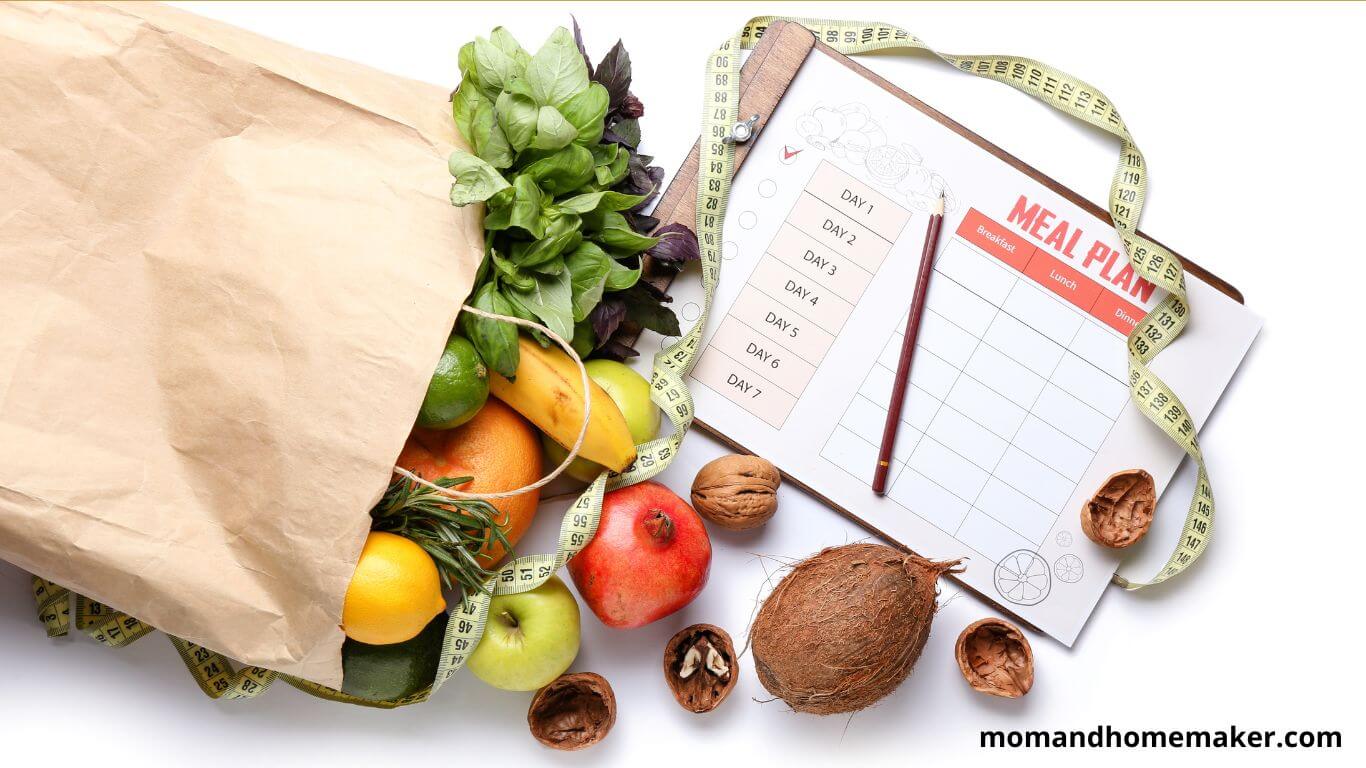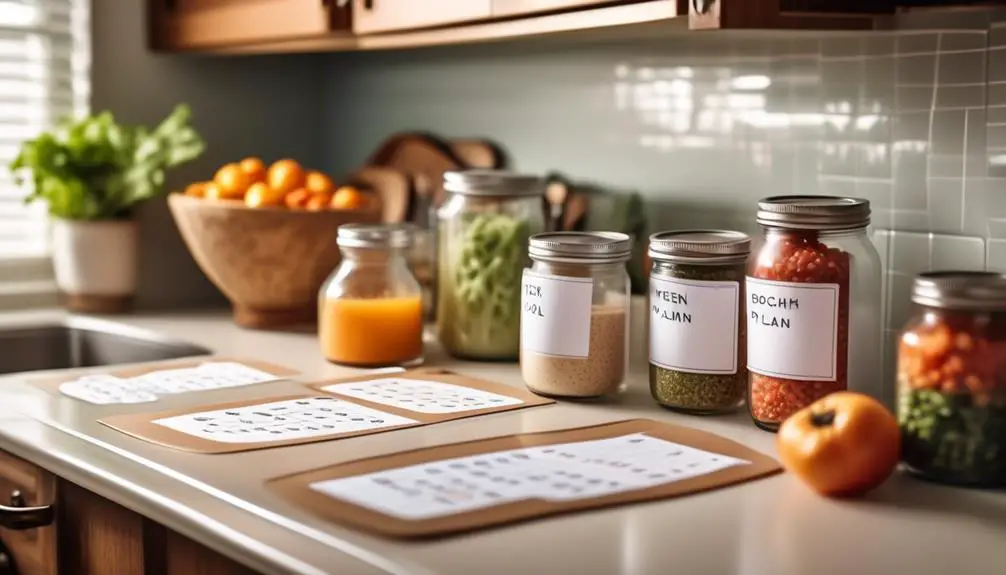When you come home after a long day at work, you’re often faced with the question of what to make for dinner. Planning meals and organizing your family’s schedule may seem overwhelming at times, but there are simple strategies to help you navigate this task.
Whether you’re a busy parent juggling multiple activities or just looking to make your daily routine more efficient, this discussion will provide you with practical tips and insights to make the process easier.
Let’s learn how you can take control of your family’s meals and schedules, one step at a time.
Benefits of Meal Planning
Meal planning has numerous benefits that make it an invaluable tool for busy families like yours. Not only does it save you time, but it also has important health benefits.
By taking the time to plan your meals ahead, you can streamline your grocery shopping and cooking processes, ultimately saving you precious time that can be spent on other family activities.
One of the biggest time-saving benefits of meal planning is that it allows you to make fewer trips to the grocery store. When you have a well-thought-out meal plan for the week, you can create a comprehensive grocery list and make just one trip to the store to get everything you need. This eliminates the need for multiple last-minute trips, saving you time and reducing stress.
In addition to saving time, meal planning can also have significant health benefits for your family. When you plan your meals, you have more control over the ingredients you use and can ensure that your family is eating a balanced and nutritious diet.
By incorporating a variety of fruits, vegetables, whole grains, and lean proteins into your meal plan, you can promote good health and provide your family with the nutrients they need for optimal growth and development.
Creating a Weekly Meal Schedule
Planning your weekly meals can save you time, money, and stress while ensuring that your family enjoys nutritious and delicious meals. It’s important to consider your family’s preferences and dietary needs when creating a meal schedule. You can also integrate meal planning with exercise to support your physical activities and promote a healthy lifestyle.
For example, you can schedule meals that provide energy before a workout or include post-workout recovery meals. This integration not only optimizes your family’s performance but also strengthens your bond as you work towards your health goals together.
Another challenge many families face is meal planning for picky eaters. It can be frustrating when certain family members reject the meals you prepare. However, with careful planning, you can cater to everyone’s preferences.
Involve your picky eaters in the meal-planning process and ask for their input. Try to incorporate their favorite foods into the schedule. Additionally, offer a variety of options within each meal, such as different sauces or toppings, so that everyone can customize their plate.
Time-Saving Tips for Busy Families
If you’re constantly juggling multiple responsibilities and struggling to find enough time in the day, here are some tips to help busy families stay organized and make the most of their limited time.
Plan Ahead: Save time by planning your meals in advance. Take a few minutes each week to create a menu and grocery list. This will help you avoid last-minute trips to the store and ensure that you have all the ingredients you need for budget-friendly recipes.
Use Time-Saving Kitchen Gadgets: Invest in kitchen gadgets that can help you save time and effort. From slow cookers to food processors, these tools can help you prepare meals more efficiently. For example, a slow cooker allows you to throw in ingredients in the morning and come home to a delicious dinner in the evening.
Prepare Meals in Bulk: Spend a few hours on the weekend prepping meals for the week ahead. Cook a large batch of soup, chili, or casserole and divide it into individual portions. This way, you’ll have ready-to-eat meals that can be easily reheated during busy weekdays.
Delegate and Share Responsibilities: Don’t hesitate to ask for help and involve your family members in meal preparation and household chores. Assign tasks to each family member, such as setting the table or chopping vegetables. Sharing responsibilities not only saves time but also fosters a sense of belonging and teamwork.
Integrating Meal Planning With Family Activities
When planning your family activities, it’s a great idea to incorporate meal planning as well. This will help you stay organized and ensure that everyone is well-fed. Plus, it can create opportunities for family bonding during mealtime. Here are some meal prep hacks to streamline your schedule and make nutritious meals for your loved ones.
One helpful hack is to prepare ingredients in advance. Chop vegetables, marinate meat, and portion out ingredients ahead of time. This way, when it’s time to cook, everything is ready to go, saving you valuable time during busy evenings.
Another useful tip is to make double batches of meals and freeze the extras. This allows you to have homemade meals on hand for those days when you don’t have time to cook from scratch.
Integrating meal planning into your family activities doesn’t mean sacrificing quality time together. In fact, it can enhance it. Plan meals that everyone can participate in preparing.
Assign tasks to each family member, creating a sense of teamwork and shared responsibility. You can even make mealtime more fun by having themed nights, like Taco Tuesdays or Pizza Fridays.
Encourage everyone to get involved in the meal planning process by asking for their input and letting them choose their favorite dishes.
How to Involve Children in Meal Planning
Getting kids involved in meal planning can be a fun and educational experience for the whole family. Here are some ideas to make it a meaningful and enjoyable process:
- Let them choose: Allow your children to pick a meal or two for the week. This not only gives them a sense of empowerment but also ensures that their preferences are taken into account. Encourage them to think about balanced options, including a variety of proteins, vegetables, and grains.
- Plan together: Set aside dedicated time each week to sit down as a family and plan the meals for the upcoming week. Involve your children in the decision-making process by asking for their input and suggestions. This will make them feel valued and like an important part of the team.
- Grocery shopping buddies: Take your kids grocery shopping with you and involve them in selecting the ingredients needed for the meals they helped plan. Teach them about making healthy choices and reading food labels. This not only educates them about nutrition but also gives them a sense of ownership over the meals they helped create.
- Hands-on cooking: Encourage your children to assist with meal preparation. Depending on their age, they can help with tasks such as washing vegetables, measuring ingredients, or stirring pots. This hands-on experience will make them proud of their contribution and more likely to enjoy the meals they helped prepare.
Budget-Friendly Meal Planning Ideas
When meal planning on a tight budget, it’s crucial to find recipes that are both delicious and affordable. Here are some budget-friendly ideas to help you make the most of your grocery budget:
For breakfast, enjoy a bowl of oatmeal topped with fresh fruits and nuts. It’s a nutritious and filling option that won’t break the bank. When it comes to lunch, try making turkey and cheese wraps with veggies on whole wheat bread. It’s a satisfying and budget-friendly choice. For dinner, why not make spaghetti with marinara sauce? It’s a classic dish that’s both tasty and affordable.
On Tuesday, start your day with a yogurt parfait made with granola and berries. It’s a simple and delicious breakfast option. For lunch, pack some tuna salad sandwiches on whole wheat bread. They’re easy to make and won’t cost you a fortune. In the evening, whip up a chicken stir-fry with vegetables. It’s a healthy and budget-friendly dinner option.
On Wednesday, treat yourself to a veggie omelette with toast for breakfast. It’s a nutritious and filling meal to start your day. For lunch, try a quinoa salad with black beans and corn. It’s a flavorful and affordable option. In the evening, make baked teriyaki chicken with rice. It’s a delicious and budget-friendly dinner choice.
On Thursday, indulge in pancakes with syrup and bananas for breakfast. It’s a comforting and affordable meal. For lunch, enjoy a grilled cheese sandwich with tomato soup. It’s a classic combination that won’t break the bank. In the evening, try making black bean enchiladas. They’re flavorful and budget-friendly.
On Friday, start your day with breakfast burritos filled with eggs, cheese, and vegetables. It’s a satisfying and affordable option. For lunch, pack chicken Caesar salad wraps with grilled chicken breast. It’s a delicious and budget-friendly choice. In the evening, make a broccoli stir-fry with beef. It’s a simple and flavorful dinner option.
Organizing Your Pantry for Efficient Meal Planning
Efficient meal planning starts with an organized pantry. By arranging your pantry in a way that allows for easy access to ingredients and efficient meal preparation, you’ll save time and ensure your kitchen is functioning at its best.
Follow these tips to create an efficient kitchen and make meal prepping a breeze:
- Categorize your pantry items: Sort your ingredients into categories like grains, canned goods, spices, and baking supplies. This simple step will make it quick and easy to find what you need when you’re in a rush to cook a meal.
- Use clear containers: Transfer your pantry items into clear containers to keep them fresh and visible. This way, you can easily see when you’re running low on an ingredient and add it to your grocery list. Plus, clear containers give your pantry a neat and organized look.
- Label everything: Take the time to label your containers and shelves. This will help you maintain order and ensure that everything is in its designated spot. It also makes it easier for other family members to help with meal preparation, as they’ll know exactly where to find what they need.
- Keep frequently used items within reach: Place the ingredients you use most often at eye level or within easy reach. This way, you won’t have to dig through your pantry every time you need them. It’s all about convenience and streamlining your cooking process.
With an organized pantry, you’ll be able to quickly and easily find the ingredients you need for your meals. This will save you time and make meal planning a much smoother process.
Meal Prep Strategies for Stress-Free Weekdays
Now that your pantry is organized and ready, let’s talk about meal prep strategies that will make your weekdays stress-free. Meal prep tips are crucial for efficient time management and ensuring that you have tasty and nutritious meals ready to go throughout the week.
First, set aside a specific time each week for meal prep. It could be a Sunday afternoon or any other day that works best for you. Dedicate a couple of hours to plan and prepare your meals for the upcoming days. By doing this, you’ll save time and energy during the busy weekdays.
Next, choose meals that can be easily prepared in advance and stored in the fridge or freezer. Make a list of your family’s favorite recipes and select ones that are simple to assemble or can be cooked in large quantities. Consider dishes like casseroles, stir-fries, or soups that can be portioned out and reheated when needed.
Invest in high-quality food storage containers to keep your prepped meals fresh and organized. Look for containers that are microwave-safe and have tight-fitting lids to prevent any leaks. Label each container with the meal and date to avoid confusion.
Another helpful tip is to prep ingredients ahead of time. Chop vegetables, marinate meats, or pre-cook grains to save time during the week. Store these prepped ingredients separately, so you can mix and match them to create different meals.
Lastly, don’t forget to involve your family in the meal prep process. Assign tasks to each family member, such as washing vegetables, measuring ingredients, or assembling meals. This not only helps you save time but also fosters a sense of belonging and teamwork.
Incorporating Dietary Restrictions Into Meal Planning
Incorporating dietary restrictions into meal planning can be challenging but necessary to ensure a healthy and satisfying eating experience for everyone in the family. When you have family members with allergies or specific dietary needs, it’s important to make sure they can still enjoy delicious meals while staying safe and healthy.
Here are some tips to help you navigate meal planning for allergies and accommodating dietary needs:
- Research and educate yourself: Take the time to understand the specific dietary restrictions or allergies that your family members have. This will allow you to make informed decisions when planning meals and ensure that you’re providing them with suitable options.
- Plan meals that can be customized: Opt for meals that can easily be adapted to accommodate different dietary needs. For example, consider making a taco night where each family member can choose their own toppings and fillings. This way, everyone can enjoy a meal tailored to their specific requirements.
- Experiment with alternative ingredients: Explore different substitutes and alternatives for ingredients that may be off-limits. There are plenty of delicious and nutritious alternatives available for common allergens like gluten, dairy, and nuts.
- Communicate and involve the whole family: Encourage open communication with your family members about their dietary needs and preferences. Involve them in the meal planning process, allowing them to contribute ideas and suggestions. This will ensure that everyone feels included and valued.
Meal Planning for Special Occasions and Holidays
When planning meals for special occasions and holidays, it’s important to consider the dietary needs and restrictions of your family members. These special events are opportunities for celebration and family togetherness, so it’s crucial to ensure that everyone can enjoy the meal without any worries or discomfort. Whether you’re hosting a birthday party, Thanksgiving, or Christmas dinner, taking into account different dietary requirements ensures that everyone feels included and can fully participate in the festivities.
Holiday meal planning can be a bit challenging because there are often traditional dishes that are expected to be served. However, with a little creativity and flexibility, you can still create a festive and delicious menu that caters to everyone’s needs.
Start by communicating with your family members well in advance to understand their dietary restrictions or preferences. This will help you plan the menu accordingly and avoid any last-minute surprises.
Consider providing a variety of options to accommodate different dietary needs. For example, if you have family members who are vegetarian, gluten-free, or have food allergies, make sure to include dishes that cater to their requirements. You can also offer alternative ingredients or substitutes for certain dishes, so that everyone can enjoy similar flavors and textures.
Remember to keep the focus on togetherness and celebration rather than solely on the food. While it’s important to provide a delicious meal, the most important thing is spending quality time with your loved ones. By considering everyone’s dietary needs and restrictions, you create an environment where everyone feels valued and included, strengthening the sense of belonging for the entire family.
Tips for Grocery Shopping With a Meal Plan
Make grocery shopping with a meal plan easier by following these helpful tips:
- Stick to Your Grocery Budget: One of the main benefits of meal planning is that it helps you stay within your grocery budget. Before going to the store, figure out how much you can spend on groceries for the week. This will help you make smarter choices and avoid buying things on impulse.
- Create a Detailed Shopping List: To make sure you have everything you need for your meal plan, make a detailed shopping list. Organize it by sections like produce, dairy, and pantry items. Having a list will keep you focused and prevent you from forgetting important ingredients.
- Take Advantage of Meal Planning Apps: Make use of meal planning apps to help you organize your meal plan, create shopping lists, and even get recipe suggestions based on what you already have. These apps can also help you find the best deals and discounts at your local grocery stores.
- Shop with a Full Stomach: It may sound strange, but shopping on an empty stomach can lead to impulse purchases and unnecessary snacks. Before heading to the store, have a satisfying meal or snack to avoid making impulsive decisions based on hunger.
Making the Most of Leftovers in Your Meal Plan
To get the most out of your meal plan and reduce food waste, it’s a smart move to find creative ways to repurpose leftovers. This not only saves you money, but also ensures that you’re making the most of the food you have.
Instead of tossing out those extra portions, why not transform them into delicious and inventive meals?
One easy way to make the most of leftovers is by using them to create wraps or sandwiches. Take that leftover roast chicken and slice it up for a tasty chicken Caesar wrap. Or use that extra steak to make a mouthwatering Philly cheesesteak sandwich. The options are endless when it comes to repurposing leftovers into handheld meals that are bursting with flavor.
Another great idea is to incorporate leftovers into a hearty soup or stew. Use those leftover roasted vegetables to whip up a comforting vegetable soup. Or add some leftover shredded chicken to a pot of homemade chicken noodle soup. By adding your leftovers to soups and stews, you not only stretch your meals, but also add depth and richness to the dish.
Let’s not forget about the power of a good casserole. Leftover pasta, vegetables, and meat can be combined with a creamy sauce and baked to perfection. For example, you can turn a leftover chili into a delicious chili mac and cheese casserole. Casseroles are a fantastic way to use up multiple leftovers and create a satisfying and comforting meal that the whole family will love.
Quick and Easy Meal Ideas for Hectic Days
During busy days, it can be challenging to find the time to cook a meal. But don’t worry, we’ve got you covered with quick and easy meal ideas that can be prepared in no time. These recipes are perfect for busy families who want to save time and still enjoy a delicious meal together.
One option is Sheet Pan Fajitas. Simply toss your favorite protein, like chicken or shrimp, with sliced bell peppers and onions on a sheet pan. Drizzle with olive oil and sprinkle with fajita seasoning. Roast in the oven for 20 minutes and serve with warm tortillas and your favorite toppings.
Another option is One-Pot Pasta. In a large pot, combine pasta, diced tomatoes, broth, and your choice of vegetables, such as spinach or mushrooms. Bring to a boil and simmer until the pasta is cooked and the sauce has thickened. Top with grated cheese and enjoy!
If you’re in the mood for Asian flavors, try a Stir-Fry. Heat some oil in a wok or large skillet and add your choice of protein, like beef or tofu. Stir-fry until cooked through and then add in a variety of colorful vegetables, such as bell peppers, broccoli, and carrots. Stir in a flavorful sauce, like soy sauce or teriyaki, and serve over rice or noodles.
For a quick and tasty option, make Quesadillas. Spread some refried beans on a tortilla and top with shredded cheese and your favorite fillings, such as cooked chicken or sautéed veggies. Fold the tortilla in half and cook in a skillet until the cheese is melted and the tortilla is crispy. Serve with salsa and sour cream.
These quick and easy meal ideas won’t only save you time but also provide a delicious and satisfying meal for your busy family. Enjoy the convenience without compromising on taste and nourishment!
Planning Healthy and Balanced Meals for Your Family
Creating healthy and balanced meals for your family is crucial for their overall well-being. By using nutritious ingredients and thoughtful meal planning, you can ensure that your loved ones receive the necessary nutrients to thrive.
Meal prep is an excellent strategy to save time and make healthier choices. Take some time on the weekend to plan out your meals for the week and do some batch cooking. This way, you’ll have ready-made meals or ingredients that can be quickly assembled during busy weekdays.
When planning meals, it’s essential to consider your grocery budget. Make a list before going to the store and stick to it to avoid impulse purchases and overspending. Look for sales and discounts on healthy staples like fruits, vegetables, lean proteins, and whole grains. Buying in bulk when possible is also a smart idea as it can help you save money in the long run.
To ensure balanced meals, aim to include a variety of food groups in each dish. Fill half of your plate with vegetables and fruits, one-quarter with lean proteins like chicken, fish, or tofu, and one-quarter with whole grains like brown rice or quinoa. Don’t forget to add a source of healthy fats, such as avocado or olive oil, to complete the meal.
Involving your family in the meal planning process can foster a sense of belonging and togetherness. Ask for their input and let them contribute ideas for meals and snacks. This way, everyone can feel included and excited about the meals being prepared.
Meal Planning Tools and Apps to Streamline the Process
When it comes to making meal planning easier, there are several great tools and apps available. These tools and apps are designed to help you organize your family’s meals and make sure you have everything you need. Here are four top-rated options to consider:
- Mealime: This app creates personalized meal plans based on your dietary preferences, allergies, and the number of people you’re cooking for. It also includes a built-in grocery list feature, making it easy to shop for the ingredients you need and reducing food waste.
- Plan to Eat: If you prefer a more hands-on approach to meal planning, Plan to Eat is a great choice. This tool allows you to import recipes from your favorite websites, drag and drop them onto a calendar, and automatically generate shopping lists. It also has a pantry feature, so you can keep track of what ingredients you already have.
- Pepperplate: Pepperplate is a comprehensive meal planning tool that lets you create and organize your own recipes, plan your meals, and generate shopping lists. It also includes a meal planner feature, where you can schedule your meals in advance and set reminders for cooking times.
- Yummly: Yummly isn’t just a meal planning app, but also a recipe discovery platform. It provides personalized recipe recommendations based on your preferences and allows you to save recipes, create shopping lists, and plan your meals. Yummly also has a smart shopping list feature that organizes ingredients by aisle, making your grocery store trips more efficient.
With these meal planning tools and apps, you can simplify the process, save time, and ensure that your family enjoys delicious and balanced meals every day. So why not give them a try and make meal planning a breeze?
Conclusion
Start meal planning and family scheduling today and experience the numerous benefits it can bring to your busy life.
By taking the time to plan your meals, involve your children, and make the most of leftovers, you’ll save valuable time, reduce stress, and ensure your family is enjoying healthy and balanced meals.
And with the help of meal planning tools and apps, you can streamline the process and make it even easier to stay organized.






